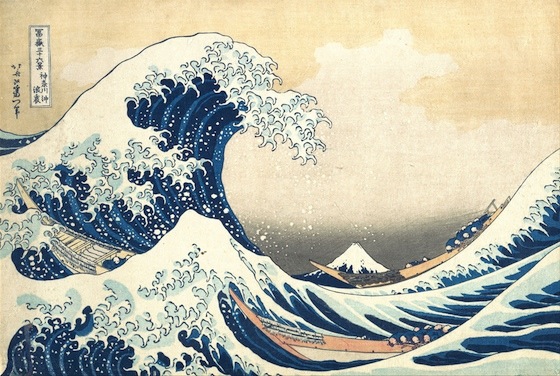The Richness of Ukiyo-e Art
For this week I'm focusing on Japanese Ukiyo-e prints from the Edo period (1603-1868) Ukiyo-e, which translates to "pictures of the floating world," is a genre of Japanese art that flourished during this time and is still appreciated today. These works were selected for their representation of the diversity and richness of Ukiyo-e art. Each piece offers a unique glimpse into Japanese culture and aesthetics, from the grandeur of nature to the subtleties of human expression. The intricate details, vibrant colors, and masterful compositions of these prints make them timeless treasures of art history.

The Great Wave off Kanagawa, Katsushika Hokusai, 1831
Country of Origin: Japan
"The Great Wave off Kanagawa" is one of the most iconic and visually striking works of Japanese art. The print captures a dramatic moment as a towering wave threatens to engulf the boats below, with Mount Fuji visible in the background. The powerful, swirling lines of the wave create a sense of movement and energy, while the contrasting calmness of Mount Fuji provides a grounding element. The use of Prussian blue ink gives the print its distinctive color and adds to the overall impact. Katsushika Hokusai was a prolific and influential Ukiyo-e artist, best known for his series "Thirty-Six Views of Mount Fuji," of which "The Great Wave off Kanagawa" is a part. Hokusai's work spans a wide range of subjects, including landscapes, flora and fauna, and everyday life. His innovative compositions and bold use of color had a significant impact on both Japanese and Western art. "The Great Wave off Kanagawa" exemplifies Hokusai's mastery of the woodblock printing technique and his ability to convey the power and beauty of nature in a single, captivating image.
Evening Bell at the Clock, Suzuki Harunobu, 1765
Country of Origin: Japan
"Evening Bell at the Clock" exemplifies the refined elegance and delicate beauty characteristic of Suzuki Harunobu's work. The print portrays a serene moment where a woman pauses to listen to the evening bell, capturing a sense of tranquility and introspection. The soft, flowing lines and subtle color palette enhance the gentle atmosphere of the scene. Specific details, such as the intricate patterns on the woman's kimono and the precise rendering of the clock, demonstrate Harunobu's meticulous attention to detail and his mastery of the Ukiyo-e technique. Suzuki Harunobu was a pioneering Ukiyo-e artist who is credited with popularizing the full-color woodblock print, known as nishiki-e. Before Harunobu, most prints were produced in monochrome or with limited colors. His innovative use of multiple color blocks allowed for more complex and vibrant images, setting a new standard in the art form. Harunobu's works often depicted scenes of daily life, beautiful women, and poetic themes, blending realism with an idealized aesthetic. "Evening Bell at the Clock" is a prime example of his ability to convey emotion and narrative through subtle visual cues, making it a timeless piece of art.
Sudden Shower over Shin-Ōhashi Bridge and Atake, Utagawa Hiroshige, 1857
Country of Origin: Japan
"Sudden Shower over Shin-Ōhashi Bridge and Atake" beautifully captures a fleeting moment in nature with remarkable detail and emotional depth. The print depicts people scurrying across the bridge, shielding themselves from a sudden downpour. The use of diagonal lines to represent the rain creates a dynamic sense of movement, while the contrast between the dark clouds and the lighter areas of the print adds to the dramatic effect. The viewer's eye is drawn to the figures on the bridge, each with a unique posture and reaction to the rain, showcasing Hiroshige's keen observation of human behavior.
Utagawa Hiroshige was a master of the Ukiyo-e genre, particularly known for his landscape prints. His work often focused on the beauty of nature and the changing seasons, capturing the essence of different times and places with a poetic sensibility. Hiroshige's innovative compositions and use of color influenced not only Japanese art but also Western artists, including the Impressionists. "Sudden Shower over Shin-Ōhashi Bridge and Atake" is part of his famous series "One Hundred Famous Views of Edo," which remains celebrated for its artistic and cultural significance.
Beauty Looking Back, Hishikawa Moronobu, 17th century
Country of Origin: Japan
As one of the earliest Ukiyo-e artists, Moronobu's works laid the foundation for later developments in the genre. This print portrays a beautiful woman glancing over her shoulder, capturing the grace and poise that would become hallmarks of Ukiyo-e beauty portraits. I chose this piece for its exquisite portrayal of a woman looking back, capturing a moment of grace and beauty. The delicate lines and intricate details in the print draw the viewer's attention to the woman's contemplative expression and the flowing patterns of her garment. Hishikawa Moronobu, a prominent artist of the Edo period, was known for his pioneering contributions to the development of Ukiyo-e prints, making this piece a significant representation of his artistic style and skill.
Works Cited
da Vinci, Leonardo, and Hishikawa Moronobu. “Beauty Looking Back | History, Description, & Facts.” Britannica, https://www.britannica.com. Accessed 2 December 2024.
“From Artist to Woodblock: Japanese Prints.” Christies, 18 June 2020, https://onlineonly.christies.com. Accessed 2 December 2023.
Harris, Leila Anne. “Under the Wave off Kanagawa (The Great Wave) by Hokusai (article).” Khan Academy, https://www.khanacademy.org. Accessed 2 December 2024.
“Harunobu (1724 - 1770) Japanese Woodblock Reprint Evening Bell of the Clock Series; Eight Views of the Parlor.” fujiarts, https://www.fujiarts.com. Accessed 2 December 2023.
Hey,
ReplyDeleteI loved all the artworks that you shared. If I had to pick my favorite, it would be the Sudden Shower over Shin-Ohashi Bridge and Atake by Utagawa Hiroshige. I think what draws me into this one is the different human emotions that are being presented. I have recently tried to do block printing. It was extremely hard to crave your design into the tile. So, I have huge respect for artists that can create such amazing artworks with similar processes and include small details. If you haven't tried block printing, I would definitely recommend it!